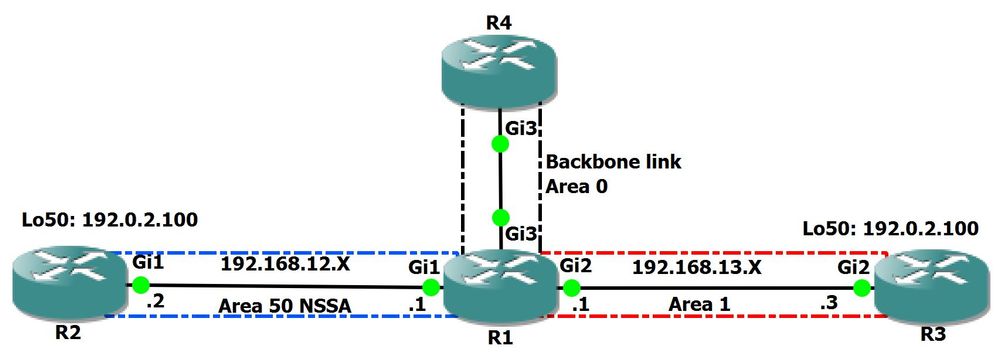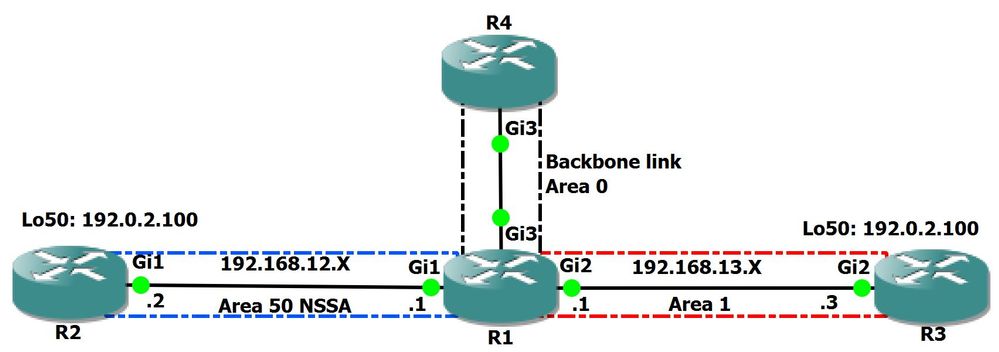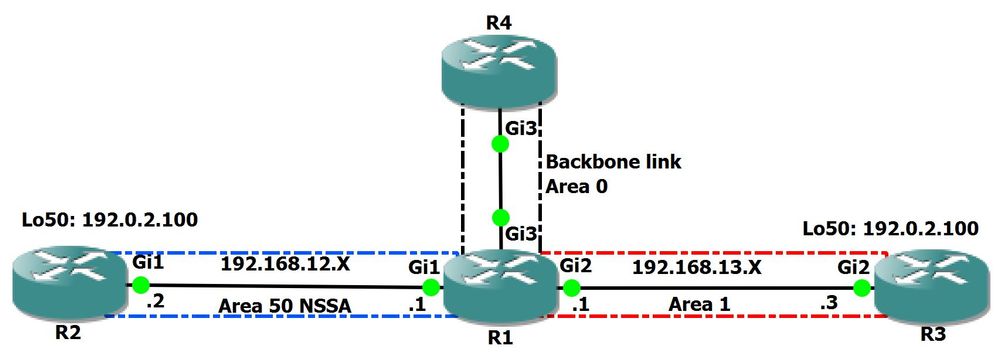OSPF Externe Pfadauswahl: Externer Typ 2 (E2) VS NSSA Typ 2 (N2)
Download-Optionen
-
ePub (184.3 KB)
In verschiedenen Apps auf iPhone, iPad, Android, Sony Reader oder Windows Phone anzeigen
Inklusive Sprache
In dem Dokumentationssatz für dieses Produkt wird die Verwendung inklusiver Sprache angestrebt. Für die Zwecke dieses Dokumentationssatzes wird Sprache als „inklusiv“ verstanden, wenn sie keine Diskriminierung aufgrund von Alter, körperlicher und/oder geistiger Behinderung, Geschlechtszugehörigkeit und -identität, ethnischer Identität, sexueller Orientierung, sozioökonomischem Status und Intersektionalität impliziert. Dennoch können in der Dokumentation stilistische Abweichungen von diesem Bemühen auftreten, wenn Text verwendet wird, der in Benutzeroberflächen der Produktsoftware fest codiert ist, auf RFP-Dokumentation basiert oder von einem genannten Drittanbieterprodukt verwendet wird. Hier erfahren Sie mehr darüber, wie Cisco inklusive Sprache verwendet.
Informationen zu dieser Übersetzung
Cisco hat dieses Dokument maschinell übersetzen und von einem menschlichen Übersetzer editieren und korrigieren lassen, um unseren Benutzern auf der ganzen Welt Support-Inhalte in ihrer eigenen Sprache zu bieten. Bitte beachten Sie, dass selbst die beste maschinelle Übersetzung nicht so genau ist wie eine von einem professionellen Übersetzer angefertigte. Cisco Systems, Inc. übernimmt keine Haftung für die Richtigkeit dieser Übersetzungen und empfiehlt, immer das englische Originaldokument (siehe bereitgestellter Link) heranzuziehen.
Inhalt
Einführung
In diesem Dokument wird das OSPF-Pfadauswahlverhalten (Open Shortest Path First) veranschaulicht, wenn ein Router sowohl ein LSA (Link-State Advertisement) vom Typ 5 als auch ein LSA vom Typ 7 für ein bestimmtes externes Netzwerk empfängt. Wenn die Neuverteilung in einem Nicht-NSSA-Bereich erfolgt, injiziert OSPF ein Typ-5-LSA in die OSPF-Domäne. Durch die Neuverteilung in einen NSSA-Bereich wird ein spezieller Typ von LSA erstellt, der als Typ 7 bezeichnet wird und nur in einem NSSA-Bereich vorhanden sein kann.
Voraussetzungen
In Abbildung 1 finden Sie das Netzwerkdiagramm, das Sie in diesem Dokument verwenden:

Abbildung 1
Im Netzwerkdiagramm sind sowohl der Non-Backbone-Bereich 1 als auch der NSSA-Bereich 50 mit R1 verbunden. R1 ist ein mit dem Backbone-Bereich 0 verbundener Area Border Router (ABR). Sowohl R2 als auch R3 sind für die Neuverteilung des gleichen Präfix 192.0.2.100/32 in die OSPF-Domäne verantwortlich.
Anforderungen
Cisco empfiehlt, das OSPF-Protokoll zu kennen.
Verwendete Komponenten
Die Informationen in diesem Dokument basieren auf den folgenden Softwareversionen:
- Cisco CSR1000V Version 16.4.1
Hintergrundinformationen
Cisco IOS-XE-Geräte unterstützen RFC 3101 für die Berechnung des externen Pfads. RFC 1587 wird durch RFC 3101 ersetzt, das RFC 1587-spezifische Verhalten kann jedoch durch Konfiguration noch aktiviert werden. In Cisco IOS Release 15.1(2)S und höheren Versionen zeigt die Ausgabe des Befehls show ip ospf, ob das Gerät RFC 3101 oder RFC 1587 verwendet.
Übersicht von RFC 3101, Abschnitt 2.5
(e) If the current LSA is functionally the same as an installed LSA (i.e., same destination, cost and non-zero forwarding address) then apply the following priorities in deciding which LSA is preferred: 1. A Type-7 LSA with the P-bit set. 2. A Type-5 LSA. 3. The LSA with the higher router ID.
Übersicht von RFC 1587, Abschnitt 3.5
5. Otherwise, compare the cost of this new AS external path
to the ones present in the table. Note that type-5 and
type-7 routes are directly comparable. Type-1 external
paths are always shorter than Type-2 external paths.
Type-1 external paths are compared by looking at the sum
of the distance to the forwarding address/ASBR and the
advertised Type-1 paths (X+Y). Type-2 external paths are
compared by looking at the advertised Type-2 metrics,
and then if necessary, the distance to the forwarding
address/ASBR.
When a type-5 LSA and a type-7 LSA are found to have the
same type and an equal distance, the following priorities
apply (listed from highest to lowest) for breaking the tie.
a. Any type 5 LSA.
b. A type-7 LSA with the P-bit set and the forwarding
address non-zero.
c. Any other type-7 LSA.
If the new path is shorter, it replaces the present paths
in the routing table entry. If the new path is the same
cost, it is added to the routing table entry's list of
paths
Szenario 1
Netzwerkdiagramm

Abbildung 2
In diesem Szenario wird untersucht, welches Verhalten bei der Verwendung von RFC 3101 für die Berechnung des externen Pfads beobachtet wird. Das Präfix 192.0.2.100/32, das sowohl auf R3 als auch auf R2 verteilt wird, ist für uns interessant.
Typ-1-LSA von R1 ist in der folgenden Ausgabe enthalten:
R1#show ip ospf database router 1.1.1.1
OSPF Router with ID (1.1.1.1) (Process ID 1)
Router Link States (Area 0)
LS age: 51
Options: (No TOS-capability, DC)
LS Type: Router Links
Link State ID: 1.1.1.1
Advertising Router: 1.1.1.1
LS Seq Number: 80000007
Checksum: 0x3BD6
Length: 48
Area Border Router
AS Boundary Router
Number of Links: 2
Link connected to: another Router (point-to-point)
(Link ID) Neighboring Router ID: 4.4.4.4
(Link Data) Router Interface address: 192.168.14.1
Number of MTID metrics: 0
TOS 0 Metrics: 1
Link connected to: a Stub Network
(Link ID) Network/subnet number: 192.168.14.0
(Link Data) Network Mask: 255.255.255.0
Number of MTID metrics: 0
TOS 0 Metrics: 1
Router Link States (Area 1)
LS age: 562
Options: (No TOS-capability, DC)
LS Type: Router Links
Link State ID: 1.1.1.1
Advertising Router: 1.1.1.1
LS Seq Number: 8000000C
Checksum: 0xEC26
Length: 48
Area Border Router
AS Boundary Router
Number of Links: 2
Link connected to: another Router (point-to-point)
(Link ID) Neighboring Router ID: 3.3.3.3
(Link Data) Router Interface address: 192.168.13.1
Number of MTID metrics: 0
TOS 0 Metrics: 1
Link connected to: a Stub Network
(Link ID) Network/subnet number: 192.168.13.0
(Link Data) Network Mask: 255.255.255.0
Number of MTID metrics: 0
TOS 0 Metrics: 1
Router Link States (Area 50)
LS age: 562
Options: (No TOS-capability, DC)
LS Type: Router Links
Link State ID: 1.1.1.1
Advertising Router: 1.1.1.1
LS Seq Number: 80000012
Checksum: 0x42CA
Length: 48
Area Border Router
AS Boundary Router
Number of Links: 2
Link connected to: another Router (point-to-point)
(Link ID) Neighboring Router ID: 2.2.2.2
(Link Data) Router Interface address: 192.168.12.1
Number of MTID metrics: 0
TOS 0 Metrics: 1
Link connected to: a Stub Network
(Link ID) Network/subnet number: 192.168.12.0
(Link Data) Network Mask: 255.255.255.0
Number of MTID metrics: 0
TOS 0 Metrics: 1
Auf R1 sind die folgenden externen LSAs in unserer Datenbank enthalten:
R1#show ip ospf database external
OSPF Router with ID (1.1.1.1) (Process ID 1)
Type-5 AS External Link States
LS age: 706
Options: (No TOS-capability, DC, Upward)
LS Type: AS External Link
Link State ID: 192.0.2.100 (External Network Number )
Advertising Router: 1.1.1.1
LS Seq Number: 80000001
Checksum: 0xE617
Length: 36
Network Mask: /32
Metric Type: 2 (Larger than any link state path)
MTID: 0
Metric: 20
Forward Address: 192.168.12.2
External Route Tag: 0
LS age: 600
Options: (No TOS-capability, DC, Upward)
LS Type: AS External Link
Link State ID: 192.0.2.100 (External Network Number )
Advertising Router: 3.3.3.3
LS Seq Number: 80000002
Checksum: 0xBFAC
Length: 36
Network Mask: /32
Metric Type: 2 (Larger than any link state path)
MTID: 0
Metric: 20
Forward Address: 0.0.0.0
External Route Tag: 0
R1#show ip ospf database nssa-external
OSPF Router with ID (1.1.1.1) (Process ID 1)
Type-7 AS External Link States (Area 50)
LS age: 865
Options: (No TOS-capability, Type 7/5 translation, DC, Upward)
LS Type: AS External Link
Link State ID: 192.0.2.100 (External Network Number )
Advertising Router: 2.2.2.2
LS Seq Number: 80000002
Checksum: 0x32BC
Length: 36
Network Mask: /32
Metric Type: 2 (Larger than any link state path)
MTID: 0
Metric: 20
Forward Address: 192.168.12.2
External Route Tag: 0
Lassen Sie uns nun prüfen, welches LSA für R1 bevorzugt wird:
R1#show ip ospf rib 192.0.2.100
OSPF Router with ID (1.1.1.1) (Process ID 1)
Base Topology (MTID 0)
OSPF local RIB
Codes: * - Best, > - Installed in global RIB
LSA: type/LSID/originator
*> 192.0.2.100/32, NSSA2, cost 20, fwd cost 1, tag 0, area 50
SPF Instance 38, age 00:04:51
contributing LSA: 7/192.0.2.100/2.2.2.2 (area 50)
contributing LSA: 5/192.0.2.100/3.3.3.3
Flags: RIB, HiPrio, ViaFwAddr, IntraNonBB, NSSA P-bit
via 192.168.12.2, GigabitEthernet1 label 1048578
Flags: RIB
LSA: 7/192.0.2.100/2.2.2.2
Wie in der obigen Ausgabe dargestellt, bevorzugt R1 LSAs vom Typ 7 von R2. Dies liegt daran, dass wir RFC 3101 befolgen, das die folgende Pfadberechnung vorzieht:
1. Ein Typ-7-LSA mit P-Bit-Einstellung.
2. Ein LSA Typ 5.
3. Das LSA mit der höheren Router-ID.
Hinweis: Beachten Sie, dass die folgende Pfaderberechnung verwendet werden kann, wenn das aktuelle LSA in seiner Funktionalität mit einem installierten LSA identisch ist. Wir können überprüfen, ob die Weiterleitungsmetrik für beide LSAs mit der Typ-1-LSAs von R1 identisch ist.
Wenn wir nun das P-Bit auf dem NSSA-Typ-7-LSA von R2 löschen, werden wir feststellen, dass Typ-5-LSA von R3 bevorzugt wird:
Übersicht von RFC 3101, Abschnitt 2.4
An NSSA internal AS boundary router must set the P-bit in the LSA header's option field of any Type-7 LSA whose network it wants advertised into the OSPF domain's full transit topology. The LSAs of these networks must have a valid non-zero forwarding address. If the P-bit is clear the LSA is not translated into a Type-5 LSA by NSSA border routers. When an NSSA border router originates both a Type-5 LSA and a Type-7 LSA for the same network, then the P-bit must be clear in the Type-7 LSA so that it isn't translated into a Type-5 LSA by another NSSA border router.
Bevor wir mit dem Löschen des P-Bit auf R2 fortfahren, sehen Sie hier die Ausgabe von Typ-7-LSA von R2.
R2#show ip ospf database nssa-external
OSPF Router with ID (2.2.2.2) (Process ID 1)
Type-7 AS External Link States (Area 50)
LS age: 1215
Options: (No TOS-capability, Type 7/5 translation, DC, Upward)
LS Type: AS External Link
Link State ID: 192.0.2.100 (External Network Number )
Advertising Router: 2.2.2.2
LS Seq Number: 80000002
Checksum: 0x32BC
Length: 36
Network Mask: /32
Metric Type: 2 (Larger than any link state path)
MTID: 0
Metric: 20
Forward Address: 192.168.12.2
External Route Tag: 0
Das P-Bit kann gelöscht werden, wenn ein NSSA-Border Router sowohl ein Typ-5-LSA als auch ein Typ-7-LSA für dasselbe Netzwerk generiert.
R2#show ip ospf database nssa-external
OSPF Router with ID (2.2.2.2) (Process ID 1)
Type-7 AS External Link States (Area 50)
LS age: 44
Options: (No TOS-capability, No Type 7/5 translation, DC, Upward)
LS Type: AS External Link
Link State ID: 192.0.2.100 (External Network Number )
Advertising Router: 2.2.2.2
LS Seq Number: 80000003
Checksum: 0xBFAD
Length: 36
Network Mask: /32
Metric Type: 2 (Larger than any link state path)
MTID: 0
Metric: 20
Forward Address: 0.0.0.0
External Route Tag: 0
Im Folgenden sind einige wichtige Merkmale der oben genannten Ausgabe aufgeführt:
- Bit P: Dieses Bit wird verwendet, um dem NSSA ABR mitzuteilen, ob Typ 7 in Typ 5 übersetzt werden soll.
- Keine Übersetzung vom Typ 7/5 bedeutet Bit P = 0.
- Die Übersetzung vom Typ 7/5 bedeutet Bit P = 1.
- Wenn Bit P = 0 ist, darf der NSSA-ABR diesen LSA nicht in Typ 5 übersetzen. Dies geschieht, wenn der NSSA ASBR auch ein NSSA-ABR ist.
- Wenn Bit P = 1 ist, muss der NSSA-ABR diesen Typ 7 LSA in einen Typ 5 LSA übersetzen. Wenn es mehrere NSSA-ABRs gibt, ist dies der mit der höchsten Router-ID.
Wenn wir nun R1 aktivieren, wird deutlich, dass Typ 5 der Typ 7 LSAs vorzieht.
R1#show ip ospf rib 192.0.2.100
OSPF Router with ID (1.1.1.1) (Process ID 1)
Base Topology (MTID 0)
OSPF local RIB
Codes: * - Best, > - Installed in global RIB
LSA: type/LSID/originator
*> 192.0.2.100/32, Ext2, cost 20, fwd cost 1, tag 0
SPF Instance 39, age 00:03:32
contributing LSA: 7/192.0.2.100/2.2.2.2 (area 50)
contributing LSA: 5/192.0.2.100/3.3.3.3
Flags: RIB, HiPrio, IntraNonBB
via 192.168.13.3, GigabitEthernet2 label 1048578
Flags: RIB
LSA: 5/192.0.2.100/3.3.3.3
Szenario 2
Netzwerkdiagramm

Abbildung 3
In diesem Szenario wird untersucht, welches Verhalten beobachtet wird, wenn RFC 1587 für die Berechnung des externen Pfads verwendet wird. Die RFC 3101-Compliance wird auf IOS-XE-Geräten automatisch aktiviert. Um die RFC 3101-Kompatibilität mit der RFC 1587-Kompatibilität für die Routenauswahl in NSSA (Not-so-Stubby Area) Area Border Routers (ABRs) zu ersetzen, verwenden Sie den Befehl kompatible FC1587 im Router-Konfigurationsmodus oder Adressfamilienkonfigurationsmodus. Um die RFC 3101-Kompatibilität wiederherzustellen, verwenden Sie die no-Form dieses Befehls.
Das Präfix 192.0.2.100/32, das sowohl auf R3 als auch auf R2 verteilt wird, interessiert uns. Zunächst müssen wir die RFC 1587-Kompatibilität auf R1 aktivieren.
R1#conf t Enter configuration commands, one per line. End with CNTL/Z. R1(config)#router ospf 1 R1(config-router)#compatible rfc1587 R1#show ip ospf | in RFC Supports NSSA (compatible with RFC 1587)
Wenn die Kompatibilität von RFC 1587 auf R1 aktiviert ist, können wir prüfen, welche Pfade in unserer Datenbank vorhanden sind und welche LSAs bevorzugt werden:
R1#show ip ospf database external
OSPF Router with ID (1.1.1.1) (Process ID 1)
Type-5 AS External Link States
LS age: 115
Options: (No TOS-capability, DC, Upward)
LS Type: AS External Link
Link State ID: 192.0.2.100 (External Network Number )
Advertising Router: 3.3.3.3
LS Seq Number: 80000003
Checksum: 0xBDAD
Length: 36
Network Mask: /32
Metric Type: 2 (Larger than any link state path)
MTID: 0
Metric: 20
Forward Address: 0.0.0.0
External Route Tag: 0
R1#show ip ospf database nssa-external
OSPF Router with ID (1.1.1.1) (Process ID 1)
Type-7 AS External Link States (Area 50)
LS age: 48
Options: (No TOS-capability, Type 7/5 translation, DC, Upward)
LS Type: AS External Link
Link State ID: 192.0.2.100 (External Network Number )
Advertising Router: 2.2.2.2
LS Seq Number: 80000005
Checksum: 0x2CBF
Length: 36
Network Mask: /32
Metric Type: 2 (Larger than any link state path)
MTID: 0
Metric: 20
Forward Address: 192.168.12.2
External Route Tag: 0
Sehen wir uns nun an, was LSA ist bevorzugt bei R1:
R1#show ip ospf rib 192.0.2.100
OSPF Router with ID (1.1.1.1) (Process ID 1)
Base Topology (MTID 0)
OSPF local RIB
Codes: * - Best, > - Installed in global RIB
LSA: type/LSID/originator
*> 192.0.2.100/32, Ext2, cost 20, fwd cost 1, tag 0
SPF Instance 44, age 00:01:56
contributing LSA: 7/192.0.2.100/2.2.2.2 (area 50)
contributing LSA: 5/192.0.2.100/3.3.3.3
Flags: RIB, HiPrio, IntraNonBB, PartialSPF
via 192.168.13.3, GigabitEthernet2 label 1048578
Flags: RIB
LSA: 5/192.0.2.100/3.3.3.3
Der Typ-5-LSA wird bevorzugt.
In der obigen Ausgabe haben Sie möglicherweise auch bemerkt, dass R1 keine Übersetzung von Type-7 in Type-5 durchführt, da nur Type-7-Routen, die der Routing-Tabelle hinzugefügt wurden, für die Übersetzung infrage kommen.
Zugehörige Informationen
Revisionsverlauf
| Überarbeitung | Veröffentlichungsdatum | Kommentare |
|---|---|---|
1.0 |
05-Jan-2018 |
Erstveröffentlichung |
Beiträge von Cisco Ingenieuren
- Aleksandar Sofranic
Cisco kontaktieren
- Eine Supportanfrage öffnen

- (Erfordert einen Cisco Servicevertrag)
 Feedback
Feedback